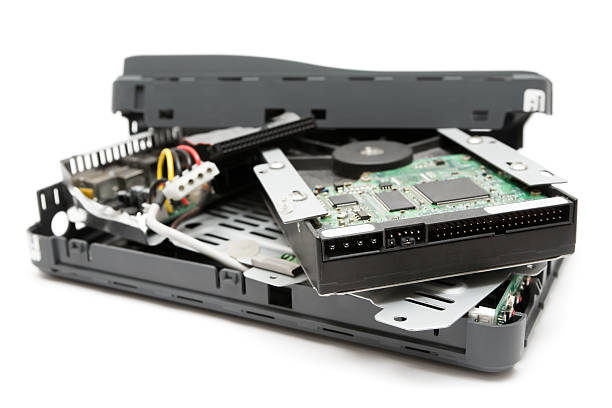
Imagine the mess you'll have to clean up in the event that your older hard drives are taken by cybercriminals. Apart from your clients withdrawing their faith in your company the cost could range from thousands or millions to fix such a situation. This is why it is important to invest in the right methods of destruction of hard drives like shredding your hard drives.
Degaussing Hard Disk Drives
It's an efficient method to clean hard drives. It's so efficient that the NSA authorized certain methods of degaussing magnetic media in order to erase high-security data. Degaussers, which are magnets with fine-tuned magnets, can destroy magnetic signatures that are stored in data when they come in contact with magnetic media, such as hdd destroyer. Magnetic degaussers are devices for destroying data is measured in the oersted rating. There are many things that determine a degausser's effectiveness however, in general, the higher the ratings in oersted and the greater the power of the degausser. There are numerous magnetic degaussers to choose from and prices for them can differ greatly.
Disassembling Hard Drives
Disintegrators are a type of equipment for data destruction that are used extensively in the data destruction and recycling industry to destroy many types of metal, for example. Hard Drive Disintegrators, such as the Data destroyer 105 Hard Drive are designed to address the particular challenges surrounding hard drives. The knife milling process employed by disintegrators for hard drives lets the hard drives be continually cut into smaller pieces that are able to traverse the screen. While disintegrating hard drives can be a bit slower than shredding hard drives, the result is a much smaller residue and a more secure. Even a tiny fragment of a drive has the potential to contain hundreds of bits of potentially dangerous data. The higher risk of destruction is probably most important in the case of data storage devices like hard drives.
Shredding Hard Drives
Shredding hard drives requires a kind of shredder specifically designed to handle the large pieces of steel that are associated with hard drives. Hard drive shredders have hardened steel cutting shafts that are equipped with wide gap sets and conveyor belts with timed timing that stop overfeeding. The shred residue left by a hard drive destroyer isn't even close to the exactness of shredder paper. The shred residue from a shredder for hard drives is composed of large chunks or metal. It is different based on the way it hits the heads of shredding and may differ greatly from one drive to the next. Users who do not wish to be in compliance with NSA or other security regulations should be shredding their drives. You could either run the hard drives through again, or use an instrument to disintegrate the hard drives that produces a smaller but more consistent substance.
Destroying Hard Drives
The most rudimentary way to sanitize information on the hard drive is physically destruction of the drive. Physical destruction isn't always easy since the majority of hard drives are constructed with aluminum housings that are reinforced and alloy platters. This is why special types of equipment for data destruction have been created to do certain heavy lifting. The most common methods for physical destruction include drilling drives crushing hard drives, cutting through hard drives, and breaking hard drives. Although the platters themselves aren't completely destroyed, the twisting of their platters can disrupt the magnetic trail which holds the data. While physical destruction doesn't protect against all kinds of forensic data recovery, it protects hard drives from most common digital data theft.
Erasing Hard Drives
Hard drive Erasure is the most common way of attempting to cleanse the data on a hard drive. This doesn't mean it's the only method. It isn't possible to erase information on your hard disk. Instead it is able to move it to another place on your hard drive. This misconception of the way that "deleting" truly works is the cause of many instances of identity theft every year.
We suggest Secure Erase as well as other methods for overwriting to erase hard drives. A properly overwritten hard drive will render information on a hard drive completely irrecoverable, even with the latest in forensic technology. Standard software applications that perform multi-pass overwriting may take hours to finish and may not be able to find information on damaged sectors on the hard drive. Secure Erase is recommended because it does not depend on the BIOS configuration of your system. Secure Erase can overwrite any data on a drive, even bad sectors. Secure Erase can be installed directly on almost all hard drive and is significantly more efficient than external overwriting software. Be sure to check out different data destruction equipment that make implementing secure erase somewhat easier than more complex methods employed by your IT staff.
Reducing Hard Drives
As per security experts according to security experts, an hard drive destroyer isn't destroyed unless it has been totally eliminated. It is generally utilized as the last step of destruction of hard drives. Many metal recycling centers will accept used hard drives as scrap metal and dump it into a boiling vessel of hot liquid metal. There's no data destruction equipment you can buy that will apply this method. If you've watched Terminator 1, then you know what happens to electronics if they come into contact with molten metal. For high security applications, this step of the declassification process is the last step due to the increased risk of data exposure in the course of transporting hard drives and delivery to unclassified and insecure places.